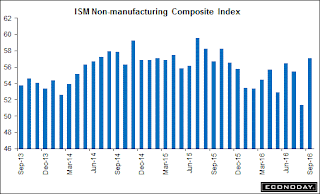Financial FAQs
Third quarter GDP growth was the fastest in two years, aided by a spike in soybean and other U.S. exports and a rebound in the size of inventories companies keep on hand for sale, reports the U.S. Bureau of Economic Analysis. Critics are saying this can’t last, because soybeans are not a dependable export, and inventories tend to fluctuate wildly. When exports drop below imports, the difference subtracts from growth.
And mainly because of full employment and rising wages, consumers are spending again and should through the holiday season. So we should see excellent GDP growth prolonged into Q4 as well.
Personal consumption expenditures rose at a solid 2.1 percent annualized rate led by an important durables component which surged at a 9.5 percent rate (i.e., things like autos that last more than 3 years). Personal consumption was the largest contributor in the quarter, adding 1.5 percentage points to the quarter's GDP rate.
Boosted by foods and specifically soybeans, exports rose at a double-digit 10.0 percent rate, more than offsetting a 2.3 percent rise in imports—which are subtracted from exports, as I said, so that net exports added 0.8 percentage points to the quarter.
Another important positive in the report is a second straight quarter of improvement in what has been low business investment. Contributing 0.2 percentage points to GDP, so-called nonresidential fixed investment rose at a 1.2 percent rate on top of the second-quarter's 1.0 percent rate. Inventory change was also a positive in the quarter (0.6 point contribution) as were government purchases (contributing 0.1 percentage points). A negative for a second straight quarter was residential investment, falling at a 6.2 percent rate and pulling GDP down by 2 tenths.
Another number that buttresses higher growth is the Employment Cost Index, a little-known indicator that tracks actual wages and benefit costs. It shows that wages and salaries are rising again, and which means more buying power for consumers.
For the third straight quarter, employer costs rose a quarter-to-quarter 0.6 percent in the third-quarter. Component contributions shifted slightly with wages & salaries down 1 tenth to plus 0.5 percent and benefits up 2 tenths to plus 0.7 percent. Year-on-year, total costs held steady at a moderate plus 2.3 percent with wages & salaries dipping 1 tenth to 2.4 percent and benefits up 3 tenths to 2.3 percent.
This doesn’t really show higher inflation, but since employment costs are two-thirds of product costs, the Fed watches it closely for that reason. But who knows? The stock and bond markets are predicting a near-term hike in short term rates, when Fed Chair Yellen hasn’t yet indicated such hikes are imminent.
Harlan Green © 2016
Follow Harlan Green on Twitter: https://twitter.com/HarlanGreen
















